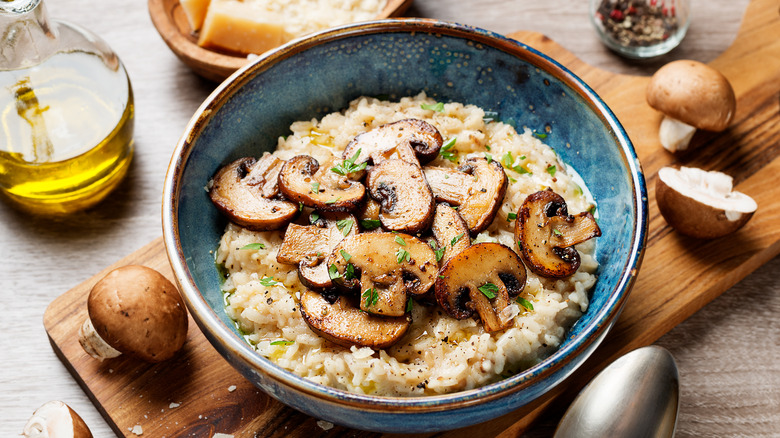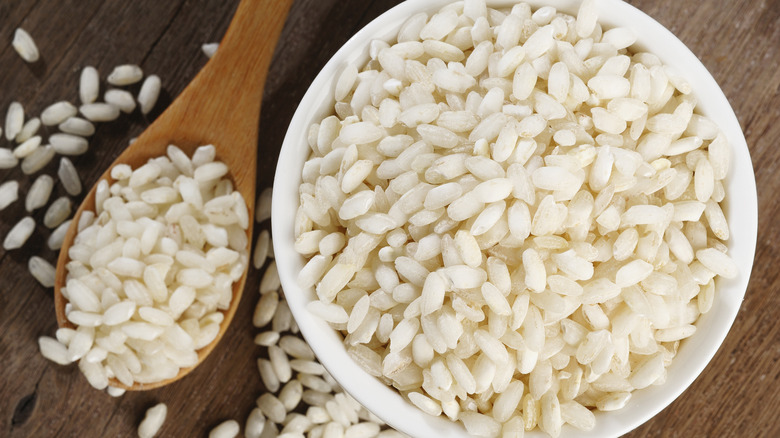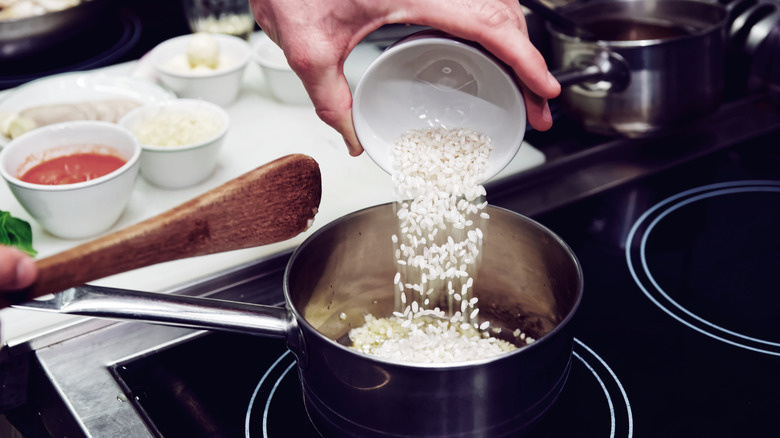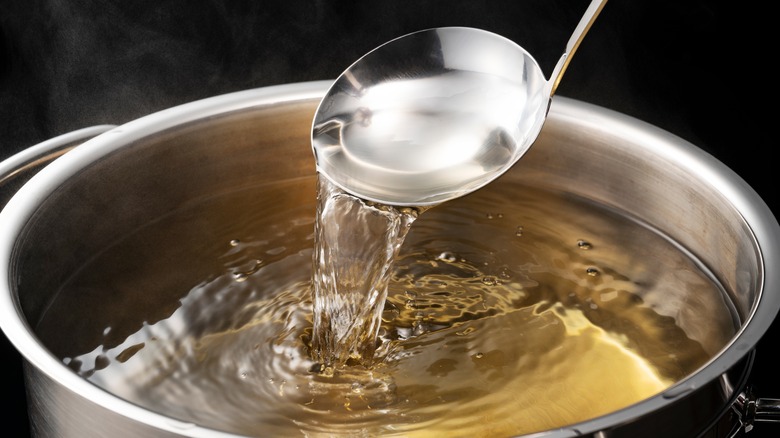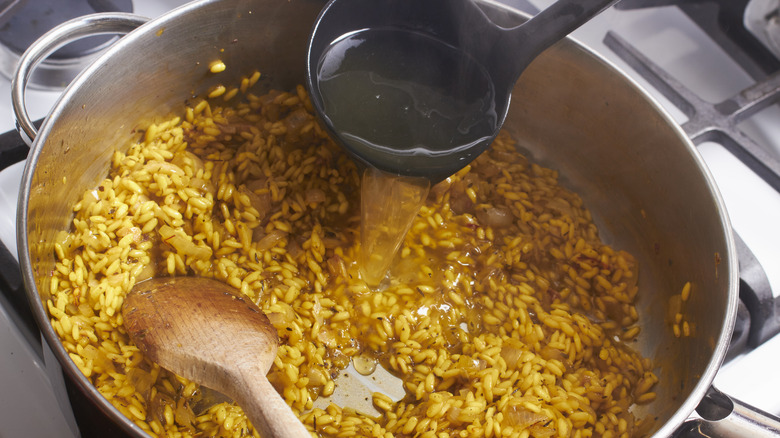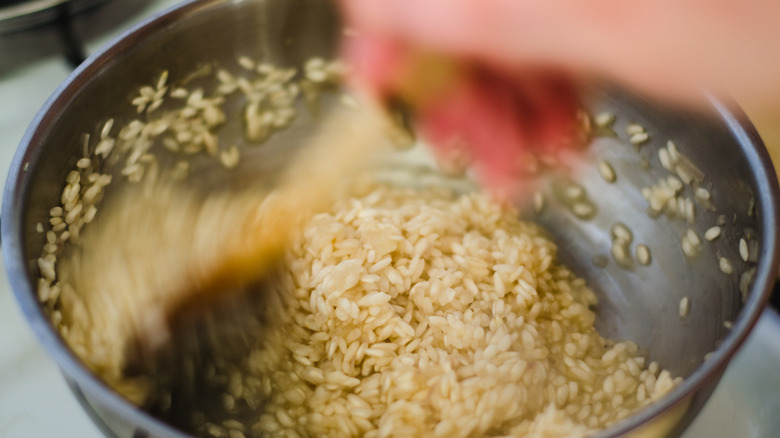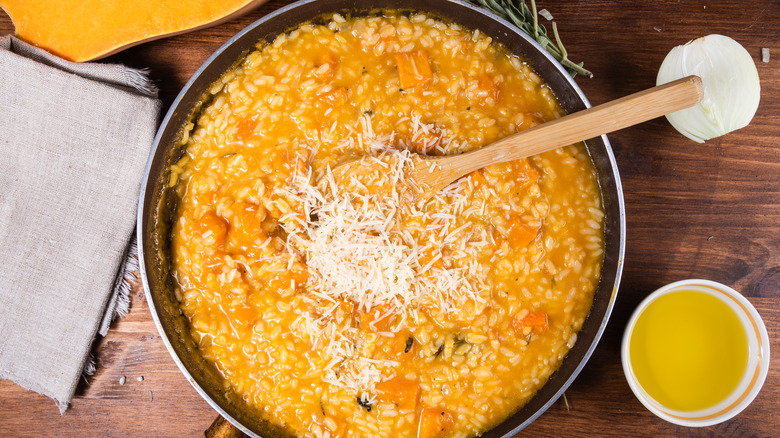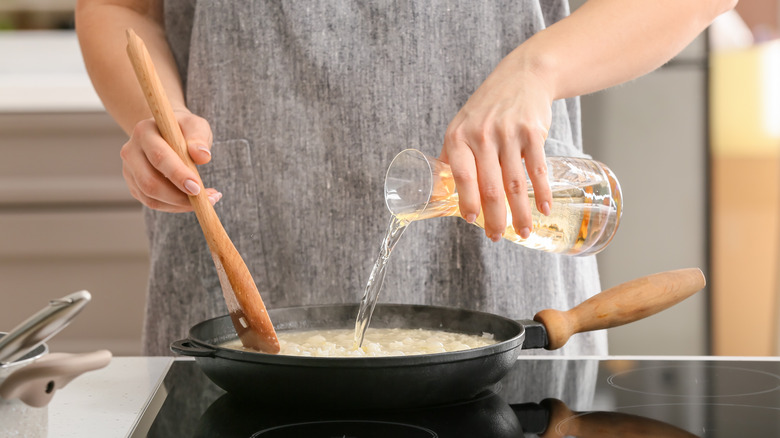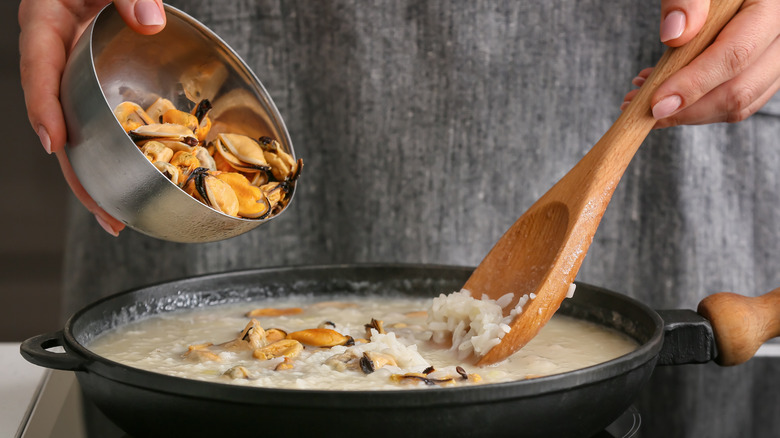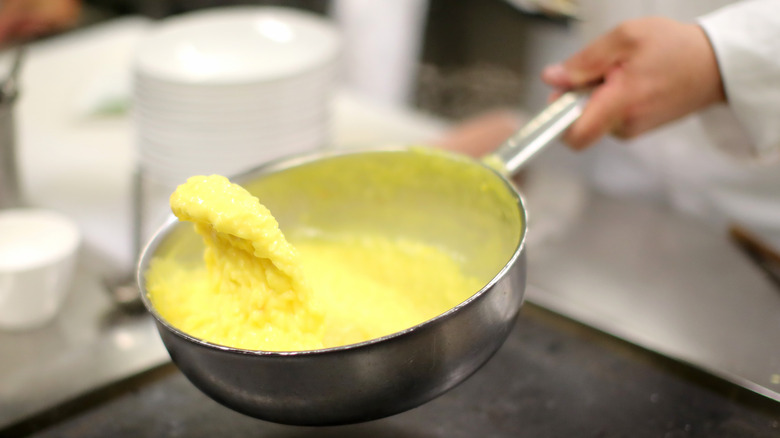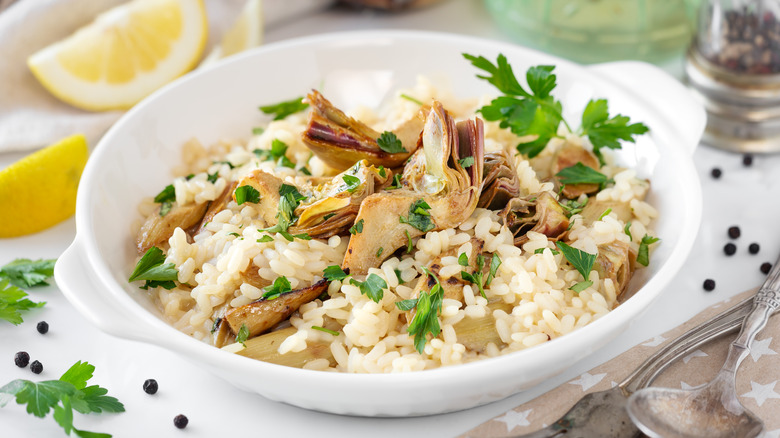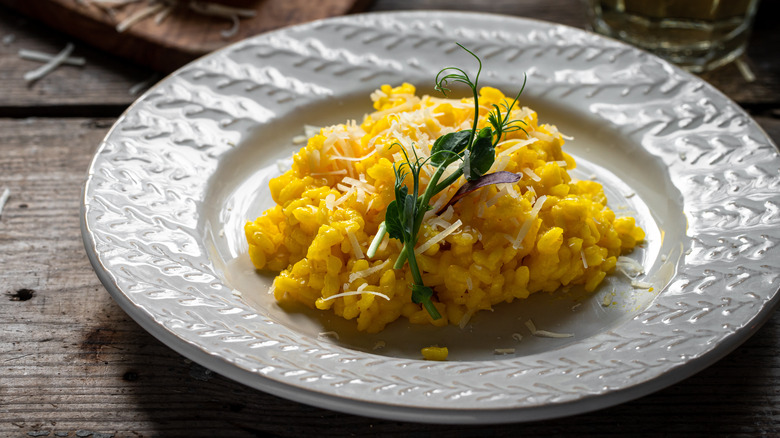11 Mistakes Everyone Makes When Cooking Risotto
Hailing from northern Italian regions, risotto has long been one of the best representatives of traditional Italian cuisine. Like most dishes from Italy, risotto is not overly complicated and does not call for the use of many components. All you need is good-quality rice and a few simple ingredients to complement it. Cheese, olive oil, and butter give risotto the final touch.
Risotto has undeservedly earned the label of a finicky dish to cook at home, but in reality, it is quite easy to whip up a fantastic risotto if you have suitable ingredients and follow the right technique. However, if you are less experienced, learning the proper risotto method might not be enough. You should also be aware of the common mistakes that often prevent you from making a decent plate of risotto.
Some of these mistakes can make or break your risotto. Others aren't so catastrophic, but will leave you with a subpar version of this classic. Thankfully, most are easy to put right. By dodging all these common blunders, you should have no trouble making risotto that always hits the mark.
1. Using the wrong rice
Rice is the foundation of every risotto. Using the wrong type will ruin the entire dish, regardless of the cooking technique used. Risotto does not take long to cook, but it does require spending some time on low heat to allow the starch from the rice to slowly release into the dish, eventually enabling it to attain that creamy, almost emulsion-like consistency. Rice varieties with less starch, mostly long grain types such as jasmine or basmati, will not be able to deliver the desired results. What you need to use are short-grained varieties that tend to have more starch content.
Arborio is the No. 1 choice when it comes to risotto rice. This short-grained rice has a distinctive, slightly ovoid shape. Because of its high starch content, it is ideal for risotto, or any other rice dish that calls for a creamy consistency. As the risotto cooks, this rice will release some of the starch, but the kernels manage to retain the bite and will not soak up too much liquid to become mushy.
Apart from arborio, several other varieties, mostly Italian, would be suitable for risotto. Carnaroli is regarded as the superior risotto rice. It is quite similar to arborio and boasts high starch content, but has slightly bigger kernels that will better hold their shape. Still, arborio is generally cheaper and more available.
2. Not toasting the rice
Even if you avoid the first big mistake and use suitable risotto rice, you can easily ruin your risotto if you do not toast the rice before you douse it in broth and add all other ingredients. Toasting is one of the essential steps when making a risotto. Before toasting, you can sauté shallots in butter or olive oil, but you can also dry toast the rice separately. Toasting should be stopped—and you will do this by adding broth or any other liquid—when all the kernels turn translucent.
Toasting will help keep your rice kernels nice and firm during cooking and can also be an additional safety measure to ensure you get a smooth, creamy risotto. As the rice is toasting, the outer shell will harden, which will help to keep the kernels from breaking and turning your risotto into a gruel-like mushy mess. Because of the firm shell, the starch will need more time to break through, and it will ooze into the risotto at a much slower pace, which is the proper way to get it to emulsify correctly. Additionally, toasting can be an excellent way to extract more of that nutty rice flavor.
Toasting is not only reserved for risotto. You can toast your rice for most dishes that require creaminess or just to deepen its flavor.
3. Using water instead of stock
Using water instead of stock is one of the most common mistakes made by less experienced risotto makers. Water should be added in stages, but it has to completely cover the rice, allowing it to cook slowly. What many people don't realize is that the rice will not only absorb the liquid but also all the flavors inside of it. As rice is so neutral tasting as is, using water will result in a dull and bland-tasting risotto. Of course, you can tweak the flavor with spices, but using stock is a straightforward way to amp up the flavors of your risotto.
The choice of broth depends on the risotto that you are making. Chicken is classic, but if you are going for a meat-packed version, any meat broth or bone stock will do. For the seafood version, the best option is to use the fish-based broth that will act as a perfect complement. Vegetable stock is suitable for vegetarians, but tends to pack a little less punch in the flavor department, so you may want to supplement with herbs like thyme or parsley.
Of course, homemade stock is best, but if you don't have anything stored, store-bought works fine. These days, there are some quality broths you can use without fearing that they'll smother all other elements.
4. Adding cold liquid all at once
Another common mistake people make when cooking risotto is simply dumping all the stock in at once and leaving the rice to simmer. However, the correct way to do it is to add stock in stages and wait until the previous addition has been absorbed to add the next. You may think there is no difference between the two approaches, as both will end with cooked rice, but there is a legitimate reason why the traditional method advises adding the liquid slowly.
Unlike many other dishes, risotto rice should not be boiled and turned into sludge. The main idea is to use enough liquid to cover the rice and then stir the mix slowly. In the process, the kernels will release their starch into the liquid. The two will create that silky smooth texture unique to risotto, but the kernels will hold shape. Dumping all the liquid at once will smother and ultimately boil down the rice, and it will not be able to perform its primary purpose in the risotto.
Also, you want to avoid adding cold stock to the warm risotto, as it will slow down the process. The correct technique is to bring your stock to a boil and then ladle portions into the risotto. As both elements are at approximately the same temperature, they will work together well, and you'll avoid disrupting the cooking process, which is desirable since interruptions tend to result in undercooked rice.
5. Leaving the risotto unattended
Risotto is a dish that requires constant attention, but many people make the mistake of leaving it unattended, thinking that giving it some time on low heat while you do dishes or prep other ingredients will make little difference. But abandoning your risotto while cooking will most certainly result in a lackluster version. Worse, you risk ending up with a burnt, unpalatable mess.
Risotto needs to be stirred as it cooks. Stirring will enable the kernels to mingle in the pan and stay in constant contact, which is the ideal way to release more starchy content. It will also help all that starch thoroughly mix with the broth, creating that desired silky-smooth quality only found in perfectly cooked risottos. Of course, you also need to stir it, because all those kernels in contact with the bottom of the skillet will get stuck and burn in no time.
However, you do not want to stir it constantly. Rice will continue to release starch into the risotto throughout the cooking process. Over-stirring might generate too much starch in the dish, and you want to avoid this as it acts as a thickening agent that might turn that luscious texture into a sticky and gluey mess.
6. Using the wrong pan
A standard error many make, especially when cooking substantial risotto portions, is choosing the inappropriate cooking vessel. Risotto is cooked stovetop, and getting that perfect result depends not only on the ingredients and the technique but also on fulfilling technical requirements that enable the required cooking process to happen.
Ideally, you want a large and shallow pan to cook the risotto. This will keep all the kernels in contact with the heat source, allowing them to cook evenly. If you use a small, tall pan where the rice will be stacked in several layers, some pieces will cook faster than the rest, and you will probably stumble on an unpleasantly crispy and undercooked kernel in the risotto. Wider, flatter pans allow equal evaporation, meaning that your risotto will cook evenly and much faster than in deeper, overfilled pans and skillets. Use a pan with sides of medium depth, as you do not want evaporation to happen too fast, resulting in an overly dry risotto.
Also, if you want to try the mantecatura technique, you need something sturdy with a long handle that will make it much easier to shift the rice across the pan.
7. Not adding alcohol
Most risotto recipes will suggest adding alcohol to your risotto, and it would be a mistake to skip this step or think of it as redundant. Alcohol has several purposes in the risotto-making process. You will typically add it before incorporating the broth, just when the rice has finished with the toasting stage. A splash of alcohol will primarily deglaze the pan, releasing the caramelized pan specks and eventually adding a touch of umami to your risotto. Of course, any alcohol will also impart some acidity and flavor, giving your dish more character and complexity. Don't worry about intoxication; most alcohol will evaporate during cooking, as you add it very early in the cooking process.
Wine is the most common option for risotto. Both red and white wines are suitable, but the final choice should depend on the type of risotto and other ingredients you want to add. Naturally, you want to use brighter and zestier white wines with risottos that have a similar profile, while heavier versions, especially those made with meat, can work with slightly more powerful red wines. Just make sure to use dry wines and avoid low-quality labels as they might ruin the dish. Besides this classic choice, your risotto will be nicely complemented with a splash of brandy. You can even go for the aromatic vermouth or a touch of dessert styles such as marsala or sherry.
8. Adding other ingredients at the wrong time
Rice may be the star of every risotto, but it is usually complemented by additional ingredients that help boost the flavor and often add texture. The list of added components suitable for risottos is virtually endless. Vegetables might be the most common addition, but meat, seafood, and sometimes fruit easily incorporate with the rice base. These ingredients can come in many shapes and sizes—occasionally even in the form of a sauce—but you should be careful not to commit that common risotto mistake of adding the ingredients too early in the process or when it's already too late.
The right time to add other elements to the risotto depends on numerous factors. Size and texture matter most, but the whole nature of the ingredient should be considered. Meat should, in most cases, be cooked separately and then added to the risotto. Add it just before the pan is removed from the heat but before mantecatura (creaming stage). Most vegetables (though this will also depend on the size and the water content) are also best pre-cooked, but you can add them to the risotto somewhere mid-cooking. Seafood is a whole different ballgame. Most seafood we traditionally add to risotto cooks in no time, so you can add it directly to the pan without pre-cooking.
9. Skipping mantecare
Mantecatura is a term closely associated with risotto, but it can apply to other dishes that call for the same technique. This term has no English counterpart, and many unknowingly skip it without realizing its importance for the successful outcome in the risotto-making process. In its basic form, mantecatura is the last stage. It involves adding butter or olive oil and cheese and then energetically mixing the risotto to encourage naturally occurring emulsification. This step amps up the creaminess of the risotto, and it should be done when the risotto is taken off the heat. If you already reached the desired consistency, you might think this is an unnecessary step, but if you are adding cheese or fat, it is essential to follow through with the technique, as this is the ideal way to incorporate all the fat into the risotto. Otherwise, the fat molecules might break the consistency.
Matecatura can be performed with spoons or similar utensils, but professionals will usually skillfully shake the pan with a unique hand movement that will swiftly move the rice across the pan. Ultimately, you want the risotto to roll in a continuous wave.
10. Not resting the risotto or resting it too long
One of the most common risotto errors relates to the resting period. Though you should always give risotto some time to rest before serving, you need to be careful not to let it sit for too long.
It would be a mistake to eat the risotto immediately. Following the creaming step, you should leave it to sit and settle. The rice will absorb some liquid, making the dish more compact but still smooth and creamy. Do not leave it out longer than five minutes, which would give the rice too much time to soak all those flavors. Risotto will stay warm for some time–especially if you leave it inside the pan–and the rice will continue to absorb all loose liquid, resulting in a firm and stiff risotto that will be stripped of all creaminess. As the rice continues to cook, it will likely go way past that ideal al dente point where it still has some bite.
It should also be noted that reheating leftover risotto is never a good idea. Rice is generally something you should never reheat, or at least not more than once, but risotto is especially finicky to reheat successfully. You are better off using the leftovers for classic Italian arancini in which the risotto is turned into deep-fried rice balls.
11. Serving in the wrong dish
The last risotto mistake might not be the worst thing you can do to your risotto, but if you managed to breeze through other items on the list and finally got that perfect version, it would be a shame to ruin the entire thing by serving on the wrong plate.
Although there are differing opinions on the serving dishes used for risotto, the general rule says it should follow pasta tradition and come served on a large shallow plate. Serving it on a large and flat vessel will help cool it down more quickly, and as you want to have your risotto right after it is cooked, this seems like the only reasonable approach. Alternatively, you can use a very shallow bowl.
It should also be noted that authentic Italian risotto is eaten with a fork. Though it does not classify as a solid or soupy dish, risotto is easily scooped down with a fork that allows you to have smaller bites and not just munch down on it at once. Dining etiquette also suggests that you should avoid fussing with your risotto. Squishing or moving the rice around the plate might ruin the texture, which took a lot of skill and knowledge to achieve and get right.
